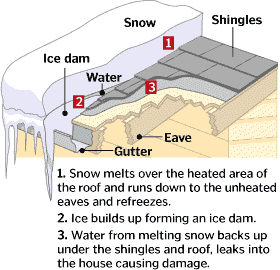…. the cold challenges many of those things we build….After the end of the next snowstorm, drive down the street and see who has the most snow on their roof. That’s usually a signal that they built their house with more insulation where it matters most-where the heat loss is greatest. The lesson here is get more insulation in your roof or replace what you have with a better type of insulation. The standard fiberglass batt insulation has a r factor of about 3 per inch of thickness while certain types of foams are 6 /inch and above, meaning you can save a lot of money on heat and fuel after investing some money on insulation and sheetrock repair. http://en.wikipedia.org/wiki/R-value_%28insulation%29#U-factor.2FU-Value
Next up -February, month of constant freeze-thaw cycles. Micro-cracks and pores in your driveway , masonry walks, patios enable melting ice and snow to infiltrate, then freeze and expand -hence the popping of the patio’s mortar and development of mega-potholes on your local roads. The lesson here is application of penetrating sealers to slow down the deterioration and slow down the freeze-thaw damage. Again, small investment for protection of larger installations.
Have you watched a guy with the shovel or snow blower toil with the aftermath of a storm, or worse be absent? When you install your next sidewalk or masonry stair, use the same technology as the airport runways-a gentle snow melting electrical heating element is low cost, and attached to a thermostat works when your custodian is asleep or has better things to do.

Don’t get me started on ice damns! read on http://www.thisoldhouse.com/toh/article/0,,1131346,00.html
You want to talk condensation?
Call 914 980 5532 now , I’ve got plenty of other cold remedies …ask for Steve!
We know that materials shrink in the cold and expand in the warmth. But did you know that materials expand and contract at different rates? This creates havoc for the skin of a building, joints have to be designed to accommodate this movement.
Remember how a cold beer can sweats on a summer day because the moisture in the hot air? Then what about when indoor heated air hits the cold exterior wall? Same deal-condensation, where does this water go? We account for this in the selection of the materials and mechanical systems we specify.
____________________
Energy codes have wisely become more restrictive as resources are more precious and better usage is not just in vogue.
Beyond reaching for a scarf on a cold January morning, we design to meet those challenges which include
